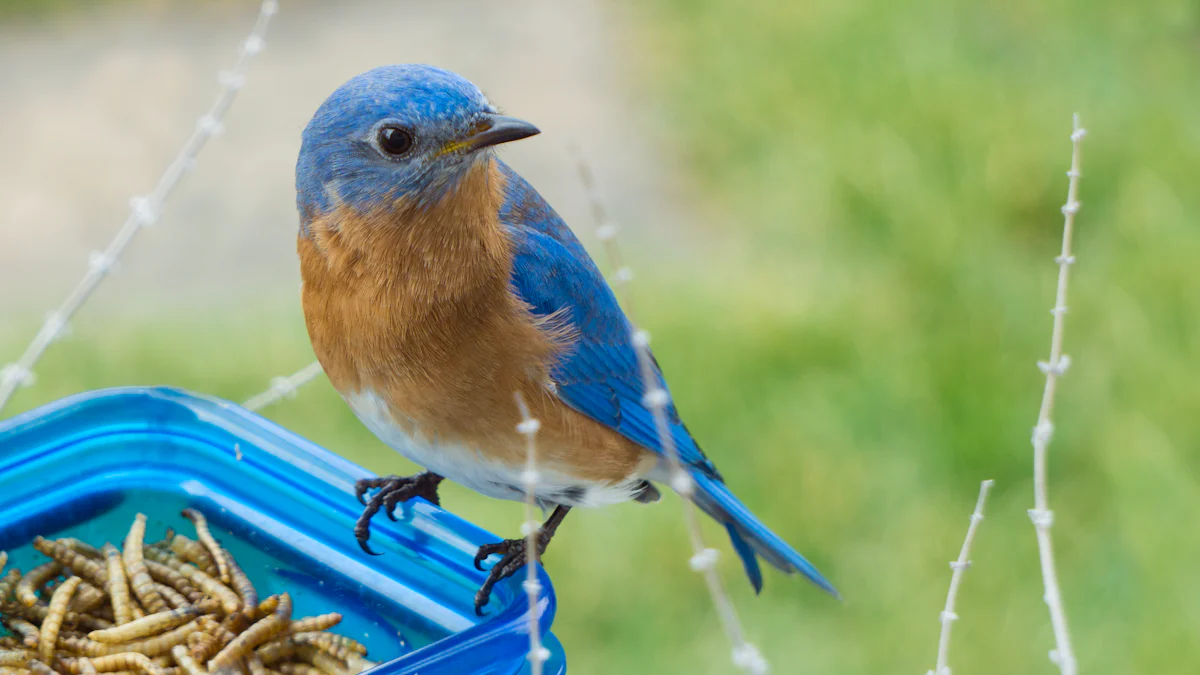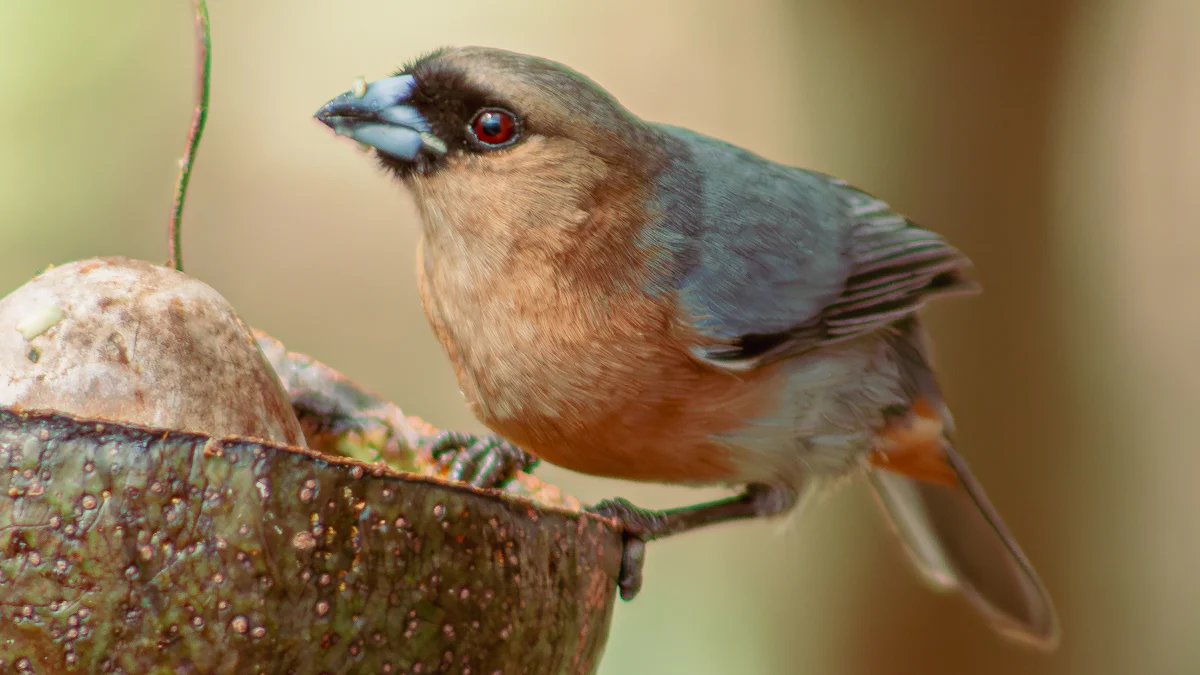
If you’re looking for a nutritious treat for your feathered friends, dried mealworms for birds are a fantastic choice. Packed with 53% protein and 28% fat, they deliver the energy birds need for flying, nesting, or surviving colder months. Plus, their long shelf life and easy storage make them a go-to option for bird lovers. Many species, like robins and bluebirds, can’t resist these tasty snacks.
Key Takeaways
- Dried mealworms are full of protein (52.8%) and good fats. They give birds the energy they need for breeding and migration.
- These mealworms last a long time and are simple to store. This makes them a handy choice for people who love birds.
- Combine dried mealworms with seeds, fruits, or nuts. This makes a healthy meal and attracts birds again and again.
Nutritional Benefits of Dried Mealworms
Protein for Growth and Energy
Protein is one of the most important nutrients for birds, and dried mealworms for birds are packed with it. With a crude protein content of 52.8%, these little treats are a powerhouse of nutrition. Birds need protein to grow strong feathers, build muscles, and stay active. It’s especially important during the breeding season or when they’re raising chicks.
Here’s a quick look at the protein content in dried mealworms:
| Nutrient | Value | |——————-|———| | Crude Protein (min)| 52.8% |
Protein also gives birds the energy they need for daily activities like flying and foraging. If you want to help your feathered friends thrive, adding dried mealworms to their diet is a great choice.
Healthy Fats for Sustained Energy
Dried mealworms for birds don’t just provide protein—they’re also rich in healthy fats. These fats act as a quick energy source, which is crucial during migration or colder months. Birds burn a lot of energy flying long distances or staying warm in winter. The fat in mealworms helps them keep going.
This energy boost also supports breeding and overall health. By offering dried mealworms, you’re giving birds the fuel they need to stay active and healthy.
Fiber and Other Nutrients for Bird Health
Fiber might not sound exciting, but it’s essential for digestion. Dried mealworms contain just the right amount to keep birds’ digestive systems working smoothly. They also provide other nutrients like vitamins and minerals that support overall health.
When you feed dried mealworms to birds, you’re giving them a balanced snack that’s both tasty and nutritious. It’s a win-win for you and your feathered visitors!
Convenience and Versatility
Long Shelf Life and Easy Storage
One of the best things about dried mealworms is how easy they are to store and use. Unlike live mealworms, they don’t need refrigeration or special care. You can keep them in a sealed container in a cool, dry place, and they’ll stay fresh for months. This makes them perfect for bird enthusiasts who want a hassle-free feeding option.
Dried mealworms also have a much longer shelf life compared to other bird food options. They don’t spoil quickly, so you won’t have to worry about frequent replacements. Plus, they’re lightweight and easy to handle, making them a convenient choice for anyone who loves feeding birds.
Suitable for Many Bird Species
Dried mealworms for birds attract a wide variety of species, making them a versatile addition to your bird-feeding routine. You’ll likely see bluebirds, chickadees, and wrens flocking to your yard. Thrushes, titmice, and nuthatches are also big fans of these tasty treats. Even kinglets might stop by for a snack!
By offering dried mealworms, you’re creating a buffet that appeals to many feathered visitors. It’s a great way to enjoy birdwatching while giving them the nutrition they need.
Use Alone or Mix with Other Foods
You can serve dried mealworms on their own or mix them with other foods to create a balanced diet. Try combining them with seeds and nuts for added variety. Birds also love them soaked in lukewarm water, which makes them even more appealing.
For an extra treat, mix mealworms with fruits like berries or apples. This adds vitamins to their diet and keeps them coming back for more. Whether you use them as a standalone snack or part of a mix, dried mealworms are a versatile option that birds adore.
How to Use Dried Mealworms for Birds

Feeding Tips and Portion Sizes
When feeding dried mealworms to birds, portion size matters. Start small, especially if birds in your area aren’t familiar with them yet. A handful of mealworms per day is usually enough for most backyard birds. During seasons when natural food is abundant, birds might not eat dried mealworms as eagerly. In that case, try soaking them in lukewarm water to make them more appealing.
If you’re introducing mealworms for the first time, consider offering live ones briefly. Birds often find live mealworms irresistible, and this can help them recognize the feeding area. Once they’re used to it, you can switch back to dried mealworms.
Attracting Birds with Mealworms
Want to attract more birds to your yard? Dried mealworms for birds are a great way to do it! To make them even more enticing, soak them in warm water for a few minutes. This softens the mealworms and makes them resemble live ones, which many birds prefer.
Another trick is to place the mealworms in a visible spot, like a platform feeder or a shallow dish. Birds are more likely to notice them if they’re easy to spot. If you’re just starting out, offering live mealworms for a short time can help draw birds to your yard. Once they’re regular visitors, you can switch to dried mealworms.
Mixing Mealworms for a Balanced Diet
While dried mealworms are nutritious, birds benefit from variety in their diet. You can mix mealworms with seeds, nuts, or even small pieces of fruit. This not only adds extra nutrients but also keeps birds interested in coming back.
For an extra treat, try combining mealworms with berries or chopped apples. Birds love the mix of protein and natural sugars. You can also sprinkle mealworms over suet cakes or mix them into birdseed blends. Experiment with different combinations to see what your feathered friends enjoy most.
Tip: Always keep your feeding area clean to prevent pests and ensure the health of visiting birds.
Considerations and Drawbacks
Cost Compared to Other Foods
When it comes to feeding birds, cost is something you might want to consider. Dried mealworms can be a bit pricier than other bird food options, but they offer great value for their nutritional benefits. Here’s a quick comparison:
| Type of Mealworm | Cost per Unit | Quantity per Unit |
|---|---|---|
| Dried Mealworms | $15 – $25 per pound | Several thousand |
| Live Mealworms | $20 for 1,000 units | Significantly less |
As you can see, dried mealworms provide a much larger quantity per unit compared to live ones. This makes them a cost-effective choice in the long run, especially since they have a longer shelf life and are easier to store.
Sourcing High-Quality Mealworms
Not all mealworms are created equal. To ensure you’re giving birds the best, look for high-quality dried mealworms. Check the packaging for details like protein content and freshness. Reputable brands often provide mealworms that are free from additives or preservatives.
You should also consider where the mealworms are sourced. Some suppliers raise mealworms in controlled environments to ensure they’re safe and nutritious. By choosing a trusted source, you can feel confident that you’re offering a healthy treat to your feathered friends.
Avoiding Overfeeding and Ensuring Variety
While dried mealworms are a fantastic snack, they shouldn’t be the main part of a bird’s diet. Overfeeding them can lead to nutritional imbalances. Wild insects provide more diverse nutrients, so it’s important to offer mealworms as a supplement rather than a staple.
Here are a few tips to keep in mind:
- Offer mealworms in moderation, just a handful per day.
- Mix them with seeds, fruits, or vegetables for a balanced diet.
- Rotate different food types to keep birds healthy and interested.
By providing variety, you’ll ensure birds get all the nutrients they need while still enjoying the tasty treat of mealworms.
Dried mealworms for birds are a fantastic choice for your feathered visitors. They’re packed with protein and healthy fats, giving birds the energy they need to thrive. You’ll love how easy they are to store and use, and birds will flock to your yard for these tasty treats. Plus, they’re more affordable than live mealworms, offering great value. Whether you’re feeding bluebirds, chickadees, or wrens, dried mealworms make bird feeding simple and rewarding.
Tip: Keep a mix of foods available to ensure birds get a balanced diet while enjoying their favorite snack!
FAQ
How do I store dried mealworms?
Keep them in a sealed container in a cool, dry place. This prevents moisture and keeps them fresh for months.
Can I feed dried mealworms to baby birds?
Yes, but soak them in warm water first. This softens the mealworms, making them easier for baby birds to digest.
Are dried mealworms safe for other animals?
Absolutely! Chickens, ducks, turtles, and even reptiles love them. They’re a nutritious treat for many pets and wildlife.


